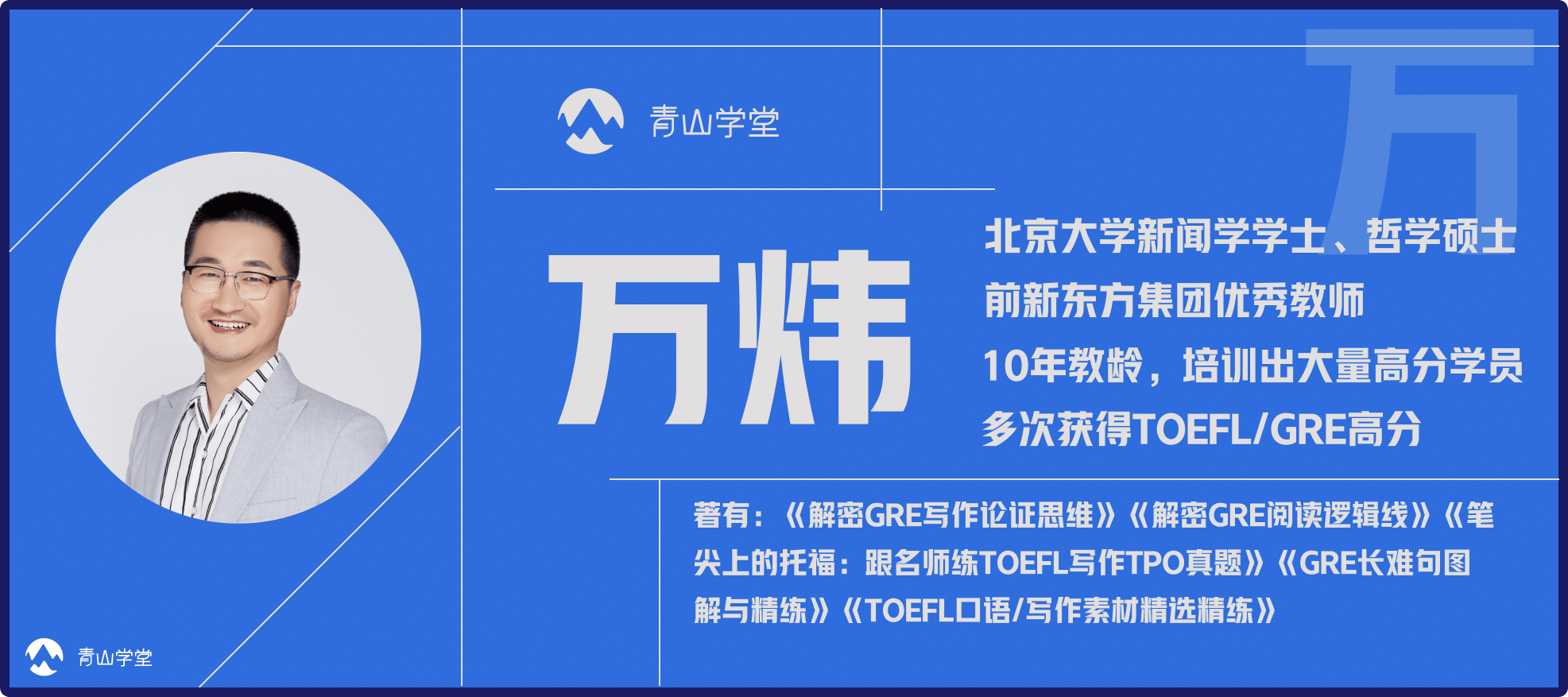干货资料 干货文章 硬核干货| 辨识GRE阅读中的“现象解释”
硬核干货| 辨识GRE阅读中的“现象解释”
作者:万炜老师 发布时间:2021-11-09

这次先让大家做一道上个月刚考过的阅读题(难倒了一片同学)。
10月考试真题
The Little Ice Age is the term given to an extended period of cooler average temperatures that affected northern Europe, in particular, from roughly 1500 to 1850. Although François Matthes, who in 1939 suggested the idea of such a period and coined the term, based his thinking on deposits indicating glacial advances and retreats in the Alps, other pertinent physical evidence was not available. Therefore, those wishing to test the idea were effectively forced to rely on the written record. Since thermometers were not invented until the late 1600s and remained rare long after that, scientists and scholars obviously had nothing like climate records in the modern sense. That does not mean there was a dearth of potentially informative data. Whether conditions were often directly mentioned in diaries and elsewhere, and agricultural output, which was highly weather dependent, could be inferred from tax records. But interpreting that data was difficult. Extreme or unusual weather was more likely to be thought worthy of comment, and a poor harvest could be caused by high or low temperatures, drought, or flood. It was only when tree-ring analysis and, still more recently, ice-core analysis could be applied that the climatic shift posited by Matthes was confirmed and could be quantified in more detail.
The author of the passage would most likely agree with which of the following statements about Matthes?
A. He sought to confirm his ideas by drawing on evidence from the written record.
B. He put forward ideas that led to the development of tree-ring analysis and ice-core analysis.
C. He denied that the Little Ice Age affected the climate outside Europe.
D. He proposed the Little Ice Age as an explanation for features of European geography.
E. He overestimated both the duration and the severity of the Little Ice Age.
这道题发到班级群里,很多同学都在挣扎了半天之后选出了正确答案,但大部分都是通过排除法一个一个否定其它选项,不得已最后选了这个正确答案。然后他们都普遍非常困惑,问我“哪里有explanation for …”这个部分???
Well,这是一个课上屡次强调的问题,并且当时我也预测过,说我再多少次强调,人们的阅读直觉仍然会让大家忽视这个问题。这次我们的主题其实就是,什么样的文章才算“现象解释”,即“explanation of a phenomenon”。
首先来看回这篇文章,第二句话,“François Matthes, who in 1939 suggested the idea of such a period and coined the term, based his thinking on deposits indicating glacial advances and retreats in the Alps”
这个部分,相信大家都可以看出来FM这个人做了一个推断,证据是deposits indicating glacial advances and retreats,结论是Little Ice Age的存在。提示到这里,我的很多学生会问:“然后呢?”然而,我看到这儿的时候,已经很明确的知道FM对某个现象(deposits indicating glacial advances and retreats)提出了一个解释(Little Ice Age)。
所谓explanation of a phenomenon,是指要去寻找导致某个现象发生的原因。
Little Ice Age是冰期,是温度下降;deposits indicating glacial advances and retreats是冰川痕迹。当我看到FM由冰川推断冰期存在,我会去思考背后的因果关系。实际上是冰期(温度下降)到来导致了冰川痕迹的出现,还是冰川痕迹的出现造成了冰期的到来?显然,前者才是合理的,因为降温了,才出现了冰川的到来。于是,这个推理当中,FM其实是由果推因。所以,FM是基于glacier推出了Ice Age,但反过来,他其实是提出了Ice Age这个理论来解释glacier这个现象,后者对应了选项中的features of geography.
其实,至此我已经把这个题应该讲清楚了,很多人会觉得自己懂了。不,你们并没有懂,这只是马后炮的讲清楚了这个选项为什么对,但没有讲清楚你们为什么错或者不会做,以及未来类似的现象你们还会遇到什么样的问题。
刚才这个题的难点,在于绝大部分人在看到文章FM做这个推理的时候最多只会看到FM由glacier推出Little Ice Age,根本不会去想这个推理是不是在进行一个解释,从而看到选项的时候甚至不会知道这应该在文章哪个地方判断,而我在第一眼看到这个推断的时候就已经判断了这是个现象解释,而且这是我的机械阅读习惯。
那么,让我来系统的讲解一下“现象解释”在阅读当中都是如何判断的。
首先,我们见到的绝大部分文章,其中的观点都是在进行现象解释,这是和GRE阅读的选题相关的。GRE阅读都是学术话题(可以对比GRE argument写作的那些文章,大部分都不是学术话题,而是日常实操话题),其中极高比例是自然科学或社会科学。科学家们提出理论为的是什么?无论是相对论、万有引力、大陆漂移、博弈论,都其实是要对观察到的自然现象或社会现象寻找原因,即进行解释。
大部分时候,解释的存在是很明显的,有直接表原因或因果关系的词去标志。判断起来并不难,比如下面几个例子。
During the Pleistocene epoch, several species of elephants isolated on islands underwent rapid dwarfing. This phenomenon was not necessarily confined to the Pleistocene, but may have occurred much earlier in the Southeastern Asian islands, although evidence is fragmentary. Several explanations are possible for this dwarfing…
The waters east of Cape Hangklip were once the center of a lucrative wild-caught abalone fishery, but illegal fishing in the mid-1990 escalated to such levels that the recreational fishery was closed in 2003. When abalones did not rebound, commercial fishing was also banned. Continue declines in abalone were attributed to poaching, but an invasion by rock lobsters during the early 1990s probably intensified the trend.
还有一些时候,文章会在开头抛出一个怪事,而怪事的存在极大概率预示着接下来文章要对怪事进行解释。
Water shrews—small mammals that live in wetlands—are skilled at finding prey underwater. With peak feeding periods occurring at night, when vision is of limited use, water shrews, researchers have found, surprisingly locate prey by smell. Logically that appears impossible: it is air that transports odorants to the olfactory receptors in the nasal cavity, and there is no air underwater for a mammal to inhale. But water shrews exhale air bubbles while foraging underwater, often directly onto objects they are investigating. They then inhale the same bubbles to collect odorants…
但非常讨厌的是,还有一些时候,文章没有任何因果关系的标志,只是单纯做了一个推理,由A推出B,比如开头举的例子,但读者需要主动思考AB之间的因果关系,一旦发现AB的推断方向和因果方向相反,就应该意识到这是一个解释,在用B解释A。
这也是解释型题目很难的地方,在逻辑单题,Argument写作中也都会出现,逢出现必是难点,因为一般人不会主动思考文章字面以外的东西,尤其是这个A推B很明显的时候,大家会很自然的觉得自己懂了,就放了过去。
In 1998 the United States Department of Transportation received nearly 10,000 consumer complaints about airlines; in 1999 it received over 20,000. Moreover, the number of complaints per 100,000 passengers also more than doubled. In both years the vast majority of complaints concerned flight delays, cancellations, mishandled baggage, and customer service. Clearly, therefore, despite the United States airline industry’s serious efforts to improve performance in these areas, passenger dissatisfaction with airline service increased significantly in 1999.
Ingestion of food containing spores of the pathogen Ascosphaera apis causes a fatal fungal disease known as chalk brood in honeybee larvae. However, larvae must be chilled to about 30°C (normal brood-comb temperature is 33-36°C) for the disease to develop. Accordingly, chalk brood is most common in spring and in small colonies. A recent study revealed that honeybees responsible for hive-temperature maintenance purposely raised the hives’ temperature when colonies were inoculated with A. apis. This “fever,” or up-regulation of temperature, occurred before any larvae died, suggesting that the response is preventative and that either honeybee workers detect the infection before symptoms are visible or larvae communicate the ingestion of the pathogen.
你能看得出来刚才例4和例5作者都是在进行现象解释吗?
例4当中,作者基于increased complaint推出increased dissatisfaction,但你应该思考两件事情谁导致谁。合理的判断应该是“不满多了”造成“投诉增多”而不是反过来,所以推断方向和因果方向相反,所以作者做了一个解释。
例5当中,作者由“病发之前蜂巢已经升温”推出“这是预防性行为,并且肯定是工蜂探测到了感染”,思考因果关系,应该是工蜂探测到了感染,为了预防疾病发作,从而主动提高了蜂巢温度,所以推断方向再一次和因果方向相反,所以作者也是做了一个解释。
好了,今天知识点的讲解到此为止。希望你明白了现象解释是如何判断的,并且在未来看到这种推断出现的时候,能够不仅仅只是读出文章的字面意思。


